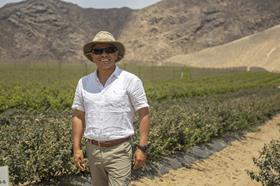
Crises generate change and progress, according to Federico Beltrán, manager of fruit consultancy Terra Business. He explains to Fruitnet why Peruvian producers should seek new opportunities amid the coronavirus pandemic.
What impact do you think the pandemic will have on Peru’s fruit export industry?
Federico Beltrán: Fortunately, our main markets have protected the food supply chain by establishing protocols to reduce risks and make the flow of produce viable. Let us not forget that this is a public health crisis and the main attribute of fruit is precisely its contribution to health.
Another positive factor for the Peruvian fruit industry is that the initial impact of the global crisis struck during a period of low agri-export activity as the grape and mango export campaign had ended.
This pause allowed us to better understand the complexity of the situation and adapt to the new protocols. Currently, the citrus and avocado campaigns are developing normally, and Peru expects to export 360,000 tonnes of avocado this season, mainly to Europe.
Having said all that, it is difficult to predict what life will be like after we have overcome this global crisis. There will undoubtedly be major changes. We do not know for sure how much demand will be affected over time by this pandemic. But in this context, it’s worth noting that the foods that make the greatest contribution to health will be those that maintain and even increase their levels of consumption and demand.
What measures should Peru take to anticipate and adapt to this new global scenario?
FB: The strategy should be to understand complexity and look for efficiencies. Adapt to the highest levels of protocol requirements and find new opportunities. Crises generate change and bring progress.
Let’s look at the speed at which the use of robotics, artificial intelligence, biotechnology, drones, automation, and online marketing systems now develops. They are the tools with which we can develop competitiveness in this new scenario. It is time to invest, risk and transform to be able to compete in the future.
In the case of the Peruvian blueberry industry, what changes should it implement to stay competitive?
FB: Peru is currently the world’s leading exporter of fresh blueberries. I estimate that in the current export campaign our shipment volume will exceed 165,000 tonnes, an increase of over 30 per cent compared to the previous campaign.
The highest harvest and export volumes begin in mid-July. We hope that many of the complexities of rearranging the supply chain will be overcome by then and we will have more clarity on the state of the markets. We must be careful to avoid the interaction of the variables of supply increase and demand contraction.
It will also be important to anticipate the regulations on social distancing that will affect the availability and cost of labour, as well as potential logistics and infrastructure problems in the supply chain.
On the plus side, widespread consumer knowledge of the health attributes of blueberries, along with their convenience and great taste, have led to a steady increase in demand from consumers all over the world.
Crucially, the strategy to increase our competitiveness amid the crisis must be based on maintaining the quality and condition of the product, while on the other hand, ensuring that markets are supplied in an organised manner.
Technology and genetics remain the key tools in helping us to achieve higher standards of competitiveness and differentiation in the markets.
This interview was first published in Blueberries Consulting magazine: https://blueberriesconsulting.com/



